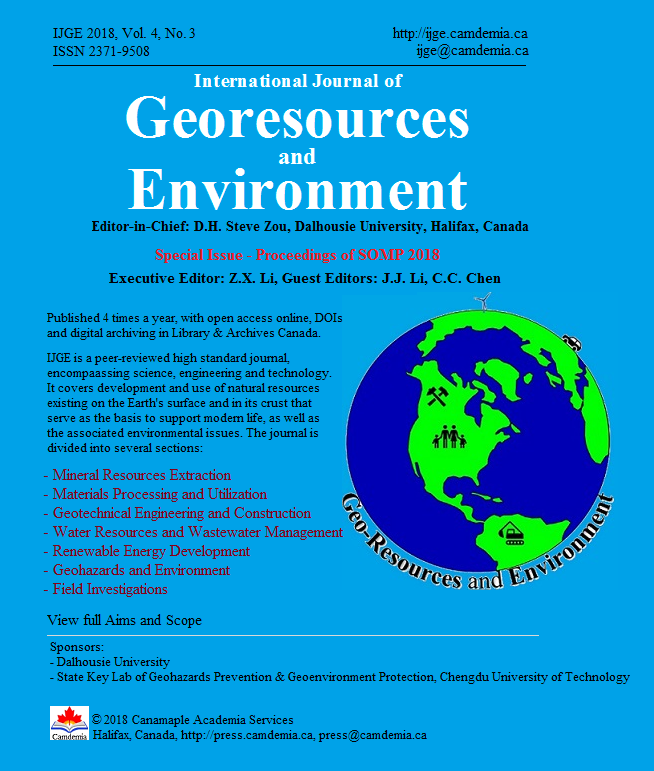Hazards Detection System Based on 3D Panorama for Tailings Dam in Mining
DOI:
https://doi.org/10.15273/ijge.2018.03.020Keywords:
tailings dam, flood drainage system, virtual reality, 3D panorama, safety hazards detectionAbstract
Tailings dam is a key facility for the mining process, which is also the major hazards for the surrounding environments. It could cause catastrophic accidents and severe personal injuries if the tailings dam failed. The occurrence of tailings dam accidents will greatly damage the life and property of the people in the surrounding areas and damage the ecological environment around the region. In recent years, Chinese government has introduced policies to step up investigation and management of mine tailings potential hazards and results in great achievements. However, a large part of the tailings dam still has prominent safety problems due to long-term site selection, design, system construction and management. Flood drainage system plays an important role both in the mining process and in the tailings dam safety. Through the analysis of the causes of tailings dam accidents, this paper discoveries that a number of accidents caused by the failure or damage of flood drainage facilities, and the risk in flood season is especially prominent. The safety hazards detection of the flood drainage is vital to secure the tailings dam safety. A safety hazards detection system based on 3D panorama technology has been achieved in this paper. It provided a new way to detect the safety hazards remotely on portable devices. Firstly, the 3D panorama data acquisition device was designed and developed. The functions and requirements of 3D panorama data acquisition device were investigated according to the actual environment of flood culvert. The structure and hardware of the device were calculated according to the target functions. Three-dimensional environment image data for rapid acquisition, and the use of feature matching and optical flow principle of the collected images were spliced to generate a 3D panoramic image of flood drainage of tailings dam in mining. The safety hazards detection system includes 3D panorama client and panorama images cloud database. It has five layers which are basic configuration layer, interface presentation layer, data management layer, function module layer and background management layer. The functional module layer has five functional modules, including mine personnel management module, tailings pond panoramic scene module, culvert potential danger detection module, interface menu navigation module and material information management module. It can help safety inspectors to detect and investigate potential safety hazards in flood drainage culverts, which would strengthen the safe operation of tailings dam and maintain the safe and sustainable production of mines. This system has been applied to the tailings dam of a mine to collect 3D environmental image data of the flood drainage culvert. The panoramic image is spliced to generate a panoramic view through the cloud platform. The results show that this system can be used in mine drainage culvert safety hazards detection.Downloads
Published
Issue
Section
License
Copyright, Terms and Conditions
The International Journal of Geohazards and Environment (the Journal) is published by Canamaple Academia Services (the Publisher) online with open access, under a Creative Commons Attribution-Noncommercial license (CC-BY-NC) (http://creativecommons.org/licenses/by-nc/4.0/). Authors (the Authors) submitting papers (the Work) for publication in the Journal automatically agree to the following terms and conditions.
1. Under the license (CC-BY-NC), Authors give permission for others to share and reuse the Work, as long as the original source and author(s) are properly cited (i.e. a complete bibliographic citation and link to the Journal website) and the material is not used for commercial purposes. Any sharing or reuse must however indicate the original CC-BY-NC license terms of the work.
2. Authors transfer and assign to the Publisher all copyright in and to the Work. However Authors retain all proprietary rights except the copyright, related to the Work and also retain the rights a) to use, reproduce, distribute, and publicly display the Work in any medium in connection with the Authors‘ academic and professional activities, such as teaching, presentations and lectures, b) to create derivative works from the Work and to make full use of the Work in future research and publications, c) to authorize others to make any non-commercial use of the Work, d) to make both the pre-published and final-published versions available online in institutional and/or disciplinary repositories or on their own websites with a citation and link to the original paper published in the Journal.
3. Authors warrant that the Work is their original work, it is not copied from anywhere or anyone else, they are totally responsible for the authenticity, originality, validity and accuracy, and the facts and views are their own, that the Work contains no matter which is defamatory or infringes any literary or proprietary rights, intellectual property rights, or any rights of privacy, and that the Work has not been simultaneously submitted to any other journals or publishers. Authors further agree that their manuscripts whether accepted or rejected will not be returned and the rejected manuscripts will be disposed at the journal editor's discretion.
Disclaimer: The Publisher, the Journal and the editors accept no responsibility for statements or opinions expressed by authors. Use of information and materials in the Journal is the sole responsibility of users.


